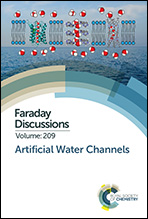Creating cross-linked lamellar block copolymer supporting layers for biomimetic membranes
Abstract
The long-standing goal in membrane development is creating materials with superior transport properties, including both high flux and high selectivity. These properties are common in biological membranes, and thus mimicking nature is a promising strategy towards improved membrane design. In previous studies, we have shown that artificial water channels can have excellent water transport abilities that are comparable to biological water channel proteins, aquaporins. In this study, we propose a strategy for incorporation of artificial channels that mimic biological channels into stable polymeric membranes. Specifically, we synthesized an amphiphilic triblock copolymer, poly(isoprene)–block–poly(ethylene oxide)–block–poly(isoprene), which is a high molecular weight synthetic analog of naturally occurring lipids in terms of its self-assembled structure. This polymer was used to build stacked membranes composed of self-assembled lamellae. The resulting membranes resemble layers of natural lipid bilayers in living systems, but with superior mechanical properties suitable for real-world applications. The procedures used to synthesize the triblock copolymer resulted in membranes with increased stability due to the crosslinkability of the hydrophobic domains. Furthermore, the introduction of bridging hydrophilic domains leads to the preservation of the stacked membrane structure when the membrane is in contact with water, something that is challenging for diblock lamellae that tend to swell, and delaminate in aqueous solutions. This new method of membrane fabrication offers a practical model for making channel-based biomimetic membranes, which may lead to technological applications in reverse osmosis, nanofiltration, and ultrafiltration membranes.

- This article is part of the themed collection: Artificial Water Channels


 Please wait while we load your content...
Please wait while we load your content...